
There can be a lot of disputes between landlords and tenants when it comes to property damage and normal wear and tear. When you’re deciding how much of the tenant’s security deposit you’re going to return at the end of the lease period, you’ll have to consider whether you’re charging that tenant for any damage that was left behind.
This is tricky for landlords. You want to hold your tenants accountable, but if your tenant files a claim against you and a judge finds that you improperly made a charge against the security deposit, you can be fined up to three times the amount of that deposit. It’s not necessarily a chance you want to take.
If you do a good job inspecting your Healdsburg rental property and documenting its condition and you can easily recognize wear and tear versus tenant damage, you should be able to protect yourself against any tenant disputes or claims.
Understanding Normal Wear and Tear
Normal wear and tear is the deterioration of a property that happens over time. It’s to be expected, and it’s generally the landlord’s responsibility when a home is being rented out. Wear and tear would happen regardless of the person living in the property, so it’s hard to hold tenants responsible. Some examples of normal wear and tear include those small nail holes in the wall from where pictures or clocks might have been hung. Scuff marks might also show up on the wall from where furniture was resting, and there may be imprints in the carpet from the same furniture, or slight wear in high traffic areas.
These are the things that you have to pay for as a property owner. If you try to charge a tenant’s deposit for items that obviously fall into the wear and tear category, you will likely get pushback from that tenant.
Identifying Tenant Damage in a Rental Home
Tenant damage is different and goes beyond wear and tear. Examples of tenant damage would be large holes in the wall or scratches and tears in the floor. If a carpet is stained or a window is broken, you can charge the deposit for these things. Anything that is the clear result of a tenant’s abuse, neglect, or misuse can be considered damage.
This is where your inspection reports are especially critical. Inspect the property carefully before a tenant moves in so you can accurately document the condition of the home. You’ll want to inspect the home after the tenant moves out and compare the pictures and the notes. If the screens are torn out of the windows and they were clearly in place and functional at move-in, you can charge the deposit. If the refrigerator door is hanging off its hinges but it was fine when the tenant moved in, you can charge for that as well.
Make sure you are careful with your documentation, and don’t forget that you’re required to offer your tenants a pre-inspection before they move out.
 If you have any questions or need help differentiating between wear and tear and tenant damage, please don’t hesitate to contact us at Healdsburg Property Management. We have the experience and the knowledge to help you with your move-out inspection and keep you protected from tenant disputes.
If you have any questions or need help differentiating between wear and tear and tenant damage, please don’t hesitate to contact us at Healdsburg Property Management. We have the experience and the knowledge to help you with your move-out inspection and keep you protected from tenant disputes.
Healdsburg Property Management manages single-family homes, duplexes, four-plexes and multi-unit properties of up to seven units throughout Sonoma County’s Wine Country, including Healdsburg, Windsor, Northern Santa Rosa, Cloverdale and Forestville.
